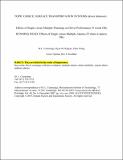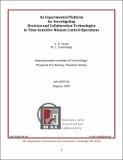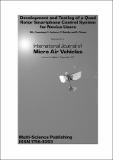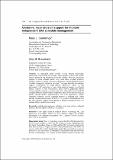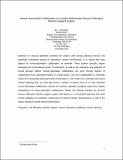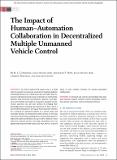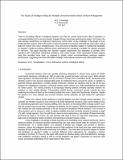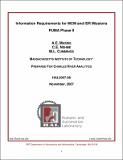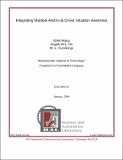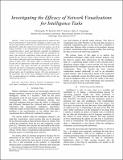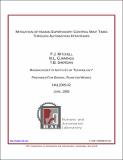Browsing Humans and Automation Laboratory by Title
Now showing items 21-40 of 69
-
Effects of Single versus Multiple Warnings on Driver Performance
(2007)Objective: To explore how a single master alarm system affects drivers’ responses when compared to multiple, distinct warnings. Background: Advanced driver warning systems are intended to improve safety, yet inappropriate ... -
An Experimental Platform for Investigating Decision and Collaboration Technologies in Time-Sensitive Mission Control Operations
(MIT Humans and Automation Laboratory, 2007)This report describes the conceptual design and detailed architecture of an experimental platform developed to support investigations of novel decision and collaboration technologies for complex, time-critical mission ... -
Field Testing of a Quad Rotor Smartphone Control System
(International Journal of Micro Air Vehicles, 2012)With recent regulatory efforts to reduce restrictions placed on the operation of Micro Air Vehicles (MAVs) in the United States, it is likely that in the next few years, these vehicles will become commonplace in the ... -
A Framework for an HSI Downselection Tool
(MIT Humans and Automation Laboratory, 2009)This technical report describes the concept and development of SITHE, the Systems Integration Tool for HSI Evaluation. SITHE is a framework for selecting tools to be used in evaluating complex technical systems in terms ... -
Global vs. local decision support for multiple independent UAV schedule management
(International Journal of Applied Decision Science, 2010)As unmanned aerial vehicles (UAVs) become increasingly autonomous, time-critical and complex single-operator systems will require advance prediction and mitigation of schedule conflicts. However, actions that mitigate a ... -
Human Supervisory Control Issues in Network Centric Warfare
(MIT Humans and Automation Laboratory, 2004)Network centric warfare (NCW) is a concept of operations that seeks to increase combat power by linking battlespace entities to effectively leverage information superiority. A network centric force must be supported by ... -
Human-Automation Collaboration in Complex Multivariate Resource Allocation Decision Support Systems
(International Journal of Intelligent Decision Technologies, 2010)In resource allocation problems for systems with moving planning horizons and significant uncertainty, typical of supervisory control environments, it is critical that some balance of human-automation collaboration be ... -
Human-Automation Path Planning Optimization and Decision Support
(International Journal of Human Computer Studies, 2011)Path planning is a problem encountered in multiple domains, including unmanned vehicle control, air traffic control, and future exploration missions to the Moon and Mars. Due to the voluminous and complex nature of the ... -
Identifying Predictive Metrics for Supervisory Control of Multiple Robots
(IEEE Transactions on Robotics, 2007)In recent years, much research has focused on making possible single operator control of multiple robots. In these high workload situations, many questions arise including how many robots should be in the team, which ... -
The Impact of Heterogeneity on Operator Performance in Future Unmanned Vehicle Systems
(2008)Recent studies have shown that with appropriate operator decision support and with sufficient automation, inverting the multiple operators to single-unmanned vehicle control paradigm is possible. These studies, however, ... -
,The Impact of Human-Automation Collaboration in Decentralized Multiple Unmanned Vehicle Control
(Proceedings of the IEEE, 2012)For future systems that require one or a small team of operators to supervise a network of automated agents, automated planners are critical since they are faster than humans for path planning and resource allocation in ... -
The Impact of Intelligent Aiding for Multiple Unmanned Aerial Vehicle Schedule Management
(IEEE Intelligent Systems, 2007)There is increasing interest in designing systems such that the current many-to-one ratio of operators to unmanned vehicles (UVs) can be inverted. Instead of lower-level tasks performed by today’s UV teams, the sole operator ... -
The Impact of Multi-layered Data-blocks on Controller Performance
(Air Traffic Control Quarterly, 2008)As a consequence of the push to increase National Airspace System capacity, air traffic control displays will not only have to show the increasing number of aircraft, but also all the associated data such as airspeed and ... -
Information Requirements for MCM and ISR Missions : PUMA Phase II
(MIT Humans and Automation Laboratory, 2007)This document contains display requirements for Littoral Combat Ship (LCS) control station displays to be used by unmanned vehicle units in support of heterogeneous unmanned vehicle missions (such as Special Operations ... -
Integrating Automobile Multiple Intelligent Warning Systems : Performance and Policy Implications
(MIT Humans and Automation Laboratory, 2006)Intelligent driver warning systems can be found in many high-end vehicles on the road today, which will likely rapidly increase as they become standard equipment. However, introducing multiple warning systems into vehicles ... -
Integrating Multiple Alarms & Driver Situation Awareness
(MIT Humans and Automation Laboratory, 2006)This study addresses this gap in CAS and intelligent alarm research by examining whether or not a single master alarm warning versus multiple warnings for the different collision warning systems conveys adequate information ... -
Interface Design for Unmanned Vehicle Supervision through Hybrid Cognitive Task Analysis
(HFES, 2012-10)While there is currently significant interest in developing Unmanned Aerial Systems (UASs) that can be supervised by a single operator, the majority of these systems focus on Intelligence, Surveillance, and Reconnaissance (ISR) ... -
Investigating the Efficacy of Network Visualizations for Intelligence Tasks
(Proceedings of IEEE International Conference on Intelligence and Security Informatics (ISI), 2013-06)There is an increasing requirement for advanced analytical methodologies to help military intelligence analysts cope with the growing amount of data they are saturated with on a daily basis. Specifically, within the context ... -
Mitigation of Human Supervisory Control Wait Times through Automation Strategies
(MIT Humans and Automation Laboratory, 2005)The application of network centric operations principles to human supervisory control (HSC) domains means that humans are increasingly being asked to manage multiple simultaneous HSC processes. However, increases in the ... -
Mixed-Initiative Strategies for Real-time Scheduling of Multiple Unmanned Vehicles
(American Control Conference, 2012)Advances in autonomy have made it possible to invert the typical operator-to-unmanned vehicle ratio so that a single operator can now control multiple heterogeneous Unmanned Vehicles (UVs). Real-time scheduling and task ...

